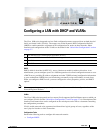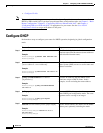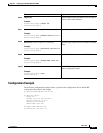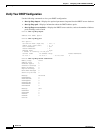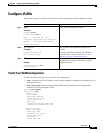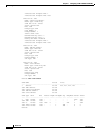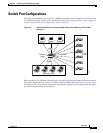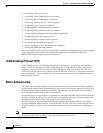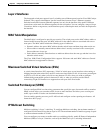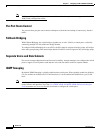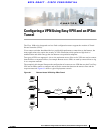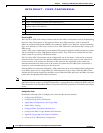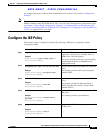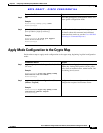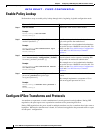
5-9
Book Title
OL-xxxxx-xx
Chapter 5 Configuring a LAN with DHCP and VLANs
Switch Port Configurations
Layer 2 Interfaces
The integrated switch ports support Layer 2 switching across Ethernet ports based on Cisco IOS Catalyst
Software. They support simultaneous, parallel connections between Layer 2 Ethernet segments.
Switched connections between Ethernet segments last only for the duration of the packet. Different
connections can be made for different segments for the next packet. You can configure a range of Layer
2 interfaces, define a range macro, set the interface speed, set the duplex mode, and add a description for
the interface.
MAC Table Manipulation
The MAC table is configured to provide port security. The switch ports use the MAC address tables to
forward traffic between the ports. All MAC addresses in the address table are associated with one or
more ports. The MAC tables include the following types of addresses:
• Dynamic address–the source MAC address that the switch learns and then drops when not in use.
• Secure address–manually entered unicast address that is usually associated with a secured port.
Secure addresses do not age.
• Static address–manually entered unicast or multicast address that does not age and that is not lost
when the switch resets.
The Cisco 1800 (Fixed) Configuration Series supports 100 secure and static MAC addresses. General
MAC addresses are supported for 50 users.
Maximum Switched Virtual Interfaces (SVIs)
A switch virtual interface (SVI) represents a VLAN of switch ports as one interface to the routing or
bridging function in the router. Only one SVI can be associated with a VLAN; it is necessary to configure
an SVI for a VLAN only when you wish to route between VLANs, when you wish to configure
fallback-bridge nonroutable protocols between VLANs, or when you wish to provide IP host
connectivity. Eight SVI interfaces are supported on each port of the fixed router
Switched Port Analyzer (SPAN)
You can configure SPAN sessions using parameters that specify the type of network traffic to monitor.
SPAN sessions allow you to monitor traffic in one or more interfaces and allow you to send ingress
traffic, egress traffic or both to one destination interface.
You can enable spanning tree on a per-VLAN basis and configure various spanning tree features. All
frames have 802.1q tags.
IP Multicast Switching
Multicast switching is Layer 3 switching. To configure Multicast switching, the maximum number of
configured VLANs must be less than or equal to 242. The maximum number of multicast groups is equal
to to the maximum number of VLANs.
You can configure your router to enable multi-cast switching globally, enable IP Protocol Independent
Multicast (PIM) on a Layer 3 interface, and verify the Multicast Layer 3 switching information.



